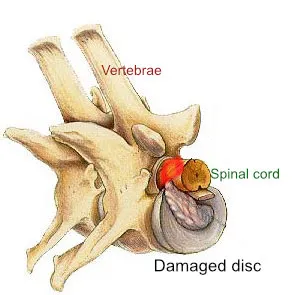Dog Back Pain (IVDD)
Intervertebral Disc Disease
For dwarfed breed dogs (Dachshund, Pekingese, Shih Tzu, toy or miniature Poodle, Cocker Spaniel, Basset Hound, Chihuahua, and Beagle) a common cause of dog back pain is disc disease. Disc disease also can occur in some large breed dogs.
 Common terms used for this kind of pain are slipped disc, bulging or herniated disc. If a small dog were to be born with the disc disease of prematurely aging discs, then it is not until the first signs of pain at 3 to 7 years old, the owner and the vet first learn the dog has IVDD.
Common terms used for this kind of pain are slipped disc, bulging or herniated disc. If a small dog were to be born with the disc disease of prematurely aging discs, then it is not until the first signs of pain at 3 to 7 years old, the owner and the vet first learn the dog has IVDD.
Disc can compress the spinal cord
Signs of cainine pain (IVDD)
A dog can have mild symptoms with solely signs of pain: yelping, reluctant to move. With a neck disc the pain can be just uses eyes- won’t turn head. Or the symptoms can increase to signs of neuro diminishment (weak or wobbly legs, loss of bladder control to paralyzed legs.)
Why dogs are not just little persons with a back pain problem
On the surface this may sound like a strange thing to alert you to the obvious fact that the anatomy of a dog is different than a human’s. However, grasping the danger that dog back pain signals, means owners have the ability recognize the need to act quickly to protect the disc and the spinal cord.
With a dog, the spinal cord goes all the way into the pelvic area and is incased in the narrow boney vertebrae. This means very often the cord gets compressed as disc material invades into the tight space of the cord’s canal.
The human’s spinal cord stops midway in the back with nerves exiting the vertebrae to the lower body limbs, etc. free from entrapment in the boney vertebral canal. There is a very real danger of the dog being paralyzed if the owners does not understand the need to quickly protect the disc.
Protecting the dog’s disc, protects against spinal cord damage
At first suspicion of a disc episode, provide 100 % STRICT rest and limited movement of the back. Get vet help to confirm with a diagnosis and start medications. The sooner the anti-inflammatory drug is started the sooner spinal cord swelling can reduce. The sooner pain meds are started the sooner your dog can begin healing in comfort .
Two treatmentss for dog back pain (IVDD)
Conservative treatment’s single most important part of the care is very STRICT %100 rest for 8 weeks. Movement of the vertebrae increases damage to the disc. Treatment includes an anti-inflammatory drug, 2-3 pain medications, and the very important acid suppressing stomach protector.
Surgery is the other treatment. Surgery is normally reserved for severe spinal cord compression to immediately remove the disc material. This decompresses the spinal cord right away. Post-op rest can range from 4-6 weeks. The dog is sent home with oral medications to provide relief from the surgery caused painful swelling.
A disc episode is not a death sentence
If for whatever reason, a surgery is not a consideration, then conservative treatment is the best choice. Dogs have success in healing their disc with conservative treatment. It is in the cards for dogs to go on after an IVDD disc episode to live man happy years ahead with their families. Both surgery and conservative treatment will take time for the body to do it’s self healing if there has been nerve damage. After the rest period post-op or after conservative treatment, then is the time to assess if money is best spent on PT to relearn the art of walking with underwater treadmill or spent on a wheelchair while waiting on the body to further self heal nerves.
Owner knowledge is key. Learn more!


Other IVDD topics
Express bladder and bowels for health
Know the discs and a success story
Traction solution improvements
Steroids vs. Non-steroidals


